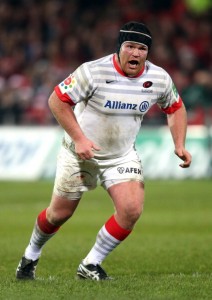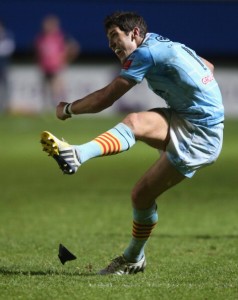
Staying in France: Jonny Wilkinson's unavailability has left the Lions short but he could join the tour at a later date
1. Lack of fly-half cover
The most glaring omission from Tuesday’s squad announcement was the lack of cover at fly-half. With Jonny Wilkinson admitting that it could be a tour too far for his battered body and needing to fulfil contractual responsibilities at Toulon, the Lions coaches have risked selecting just two No 10s. Greig Laidlaw was an option to cover both half-back positions, and consummate utility back James Hook could have covered fly-half and virtually half the backline, but they were both deemed surplus to requirements. It has been mooted that Stuart Hogg, richly talked up by the Lions management, may be asked to cover there, starting against the BaaBaas in Hong Kong. However, with very little, if any, top-level experience in a key role, it’s quite a burden to put on a 20-year-old.
2. Front-row gambles
There was an audible gasp when the name of Matt Stevens was announced by Tour manager Andy Irvine. The South African, naturalised Englishman, has quite a story. A Test Lion by 2005, he followed it with an adept X-Factor turn, a two-year ban for cocaine, the opening of a coffee shop and now finally redemption at Saracens. Tipping the scales at over 20st, he is still a sizeable ball-carrier, can play on both sides of the scrum and has World Cup pedigree, but nevertheless, it is still a roll of the dice for someone who hasn’t played international rugby for 15 months. His young colleague Mako Vunipola is also far from the finished product in the scrummaging department as Adam Jones proved when teaching the 22 year-old a valuable lesson in their Six Nations encounter.
3. One left wing
On the flank, there are three recognised international right-wings; Tommy Bowe, Alex Cuthbert and Sean Maitland, and a solitary left-wing, George North, who only moved sides when Shane Williams hung up his size 7s. While modern-day players are expected to be interchangeable, in the high-pressure Test match environment, a nano-second of hesitation, whether it’s poor positioning or a sloppy kick on a weaker foot, could heap unnecessary pressure on the Lions. Leigh Halfpenny has played there for Wales, but he is expected to be deployed as a full-back. Simon Zebo, the owner of a cultured left boot, was mentioned in dispatches by Warren Gatland and can expect to be on standby.
4. Route one midfield
Save for the ‘dainty’ Brian O’Driscoll, who in the latter years of his career has, at times, resembled an extra backrow, the Lions midfield is replete with intimidating physical specimens. Manu Tuilagi, Jonathan Davies, and Jamie Roberts are all over 6ft and 16st. They can thump holes into the most robust of defences and bring attackers to a shuddering halt, but lack a certain trickery and cunning. Gatland has said Tuilagi and Roberts have a limited kicking games, and Jonathan Davies was the first to castigate himself for a few errant passes after a poor game against Ireland. If O’Driscoll is not at his creative best, there is the lack of an artiste if route one is not working. The omission of James Hook and Billy Twelvetrees, who both offer vision, a varied kicking game and soft hands could be at best, foolhardy, at worst, fatal.
5. Wrecking-ball No. 8
Are the Lions missing a No 8 with the ability to skittle over the opposition and put them on the front foot? In 2001, they had behemoth Scott Quinnell to do the job, a man adept at dragging in defenders to release attackers. In 2005, a young Ryan Jones joined the tour late to wreak havoc on All Black playing fields. On this tour, Toby Faletau and Sean O’Brien are the closest the Lions have to destructive ball-carriers in the backrow but you seldom see attackers knocked on their behinds, in the way as someone like Gloucester’s Ben Morgan does. Granted, it’s a minor point, but even minor points can prove the difference in a Test Series.







